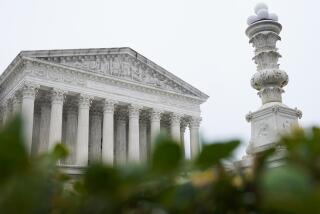In Seattle, reactions are emotional
SEATTLE — Her struggle for composure lost, parent Kathleen Brose wept Thursday over the Supreme Court’s decision Thursday vindicating her claim that the local school district’s racial-diversity practices discriminated against her daughter.
“I don’t want any parent to go through what we went through,” Brose told a group of reporters. “It shouldn’t matter what color any kid is. Everyone should have access to great schools.”
After seven years of legal wrangling, Brose said, “I’m glad it’s over.”
Reaction here to the high court’s ruling -- from both sides -- has been emotional and complex.
Brose led a group of Seattle parents in a 2000 lawsuit against the district after her daughter Elisabeth failed to get into her top choice of high school because of her skin color. The Broses are white. Elisabeth’s top choice was closest to home, but she ended up commuting 30 minutes to a school across town.
At issue was the district’s use of a “racial tiebreaker” policy as a way of deciding which students got to attend the city’s most popular schools. A student’s race was considered if it helped bring the school in line with the district’s overall racial balance: 60% nonwhite and 40% white. The practice helped minority students get into predominantly white schools and vice versa.
Lower courts upheld the district’s racial tiebreaker, but the Supreme Court voted 5 to 4 against Seattle’s policy and that of Louisville, Ky. The Kentucky case also involved a mother whose white child was denied enrollment at her favored school. The high court decision could imperil similar practices in hundreds of school districts across the country.
Harry Korrell, the attorney representing Brose and her parents group, called the decision “a sweeping victory for students and parents everywhere.”
On the other side, the Seattle School District and its supporters expressed disappointment but nevertheless claimed a moral victory, contending the court rejected the district’s method while backing its overall goal of achieving racial diversity in schools.
These supporters found solace in Justice Anthony M. Kennedy’s opinion that, though the policies in Seattle and Louisville may have gone too far, “race may still be a component of plans to achieve diversity in schools.”
Seattle School Board President Cheryl Chow, in a statement, focused on that part of the court’s message.
“This decision clearly affirms that the door for increasing diversity in public education remains open,” Chow said, explaining that the ruling gives school districts “greater guidance” in reaching diversity goals.
Seattle schools Supt. Raj Manhas emphasized his belief that the court ultimately “upheld the value of diversity in the schools.”
As the case has been winding its way through the legal system, the school district has not used the racial tiebreaker for five years. The result has been what the district predicted, school officials said.
“Our fears in terms of the schools involved becoming more racially segregated have been realized,” Manhas said. He cited Ballard High School, where Elisabeth Brose tried to enroll. Enrollment there has gone from 58% white in 2000 to 62% white.
Iris Okimoto-Nielsen, who has been involved in the local parent-teacher association for 14 years, said her gut reaction was sadness.
She said the main problem facing schools is the growing academic achievement gap between racial groups. The decision, she said, could widen the gap.
“It makes me sad that families who don’t have the income may not have the opportunity to go to better-endowed schools,” Okimoto-Nielsen said. “On the other side, it’s too bad that kids who go to one-cultured schools may not get the opportunity to learn about other cultures and people.”
--
More to Read
Sign up for Essential California
The most important California stories and recommendations in your inbox every morning.
You may occasionally receive promotional content from the Los Angeles Times.










